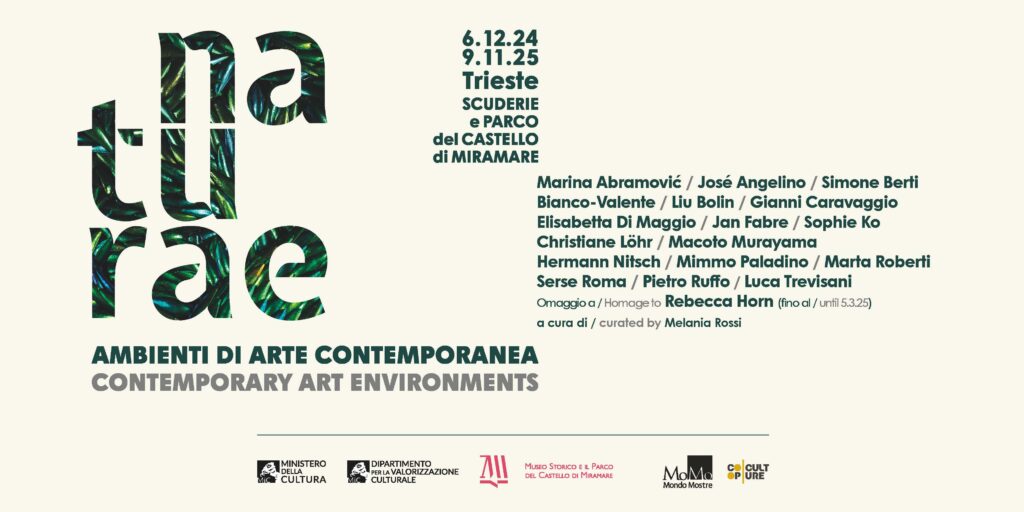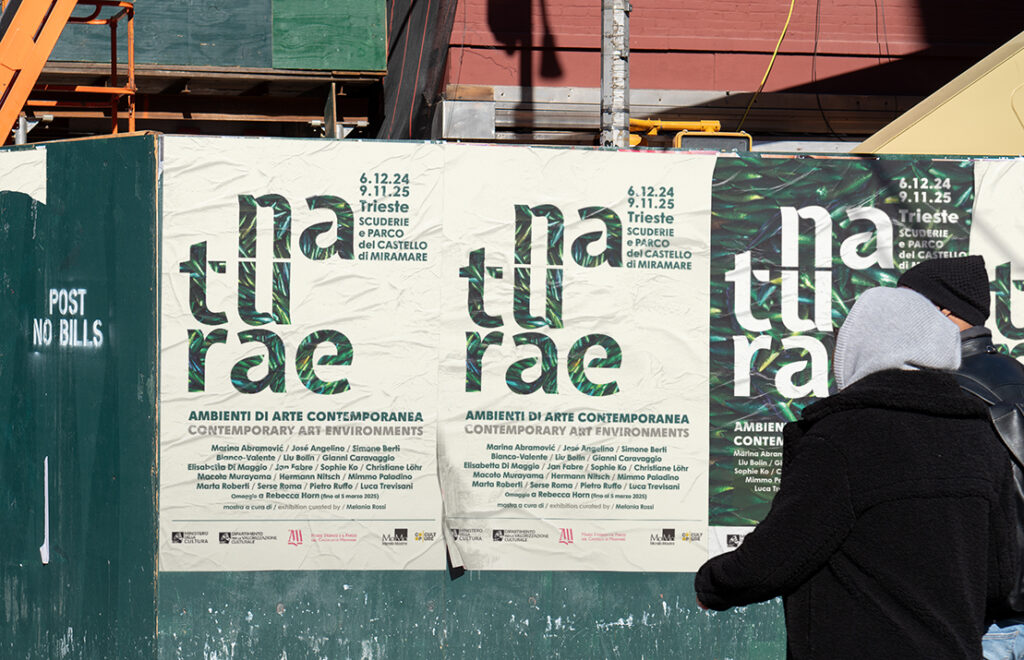Naturae / ambienti di arte contemporanea / contemporary art environments
Scuderie e Parco del Castello di Miramare | Italia, Trieste | 6 dicembre 2024 – 9 novembre 2025

Il concept grafico della mostra “Naturae” è stato sviluppato per evocare un tributo alla natura, intrecciando rigore visivo con dettagli che suggeriscono morbidezza e vita organica. Ogni elemento è stato scelto per arricchire l’esperienza percettiva e sostenere l’interazione tra pubblico e opere esposte.
Scelta dei Font
Per i titoli / temi delle sale, abbiamo scelto il font Expletus, un carattere che nasce come sans serif ma introduce piccole curve e lievi distaccamenti. Questa scelta è un omaggio alla natura stessa, una forma di “irregolarità controllata” che richiama l’idea della natura come entità indomabile e imprevedibile. Expletus riflette l’impressione fugace e spesso incompleta che abbiamo di fronte alla bellezza della natura – come l’immagine sfocata che il sole lascia nei nostri occhi.
Per i testi esplicativi e le descrizioni sugli artisti, abbiamo invece adottato il font Century Gothic, scelto per la sua pulizia e leggibilità. Century Gothic si presenta lineare, con un corpo chiaro e un punto di dimensioni per i testi alto, per agevolare una lettura piacevole. La sua sobrietà e la semplicità dei tratti creano un contrasto bilanciato con l’eleganza del Expletus, evitando sovrapposizioni visive ma valorizzando ogni contenuto.
Scelta dei Colori
Abbiamo optato per una palette di colori studiata per armonizzare con l’essenzialità grafica della mostra senza rinunciare a un tocco di carattere. Il verde scurissimo, una tonalità che oscilla tra il petrolio e il verde selva, è stato scelto per la sua profondità e per il richiamo alla natura stessa. Questo colore si trova sui testi in italiano e rappresenta una nota di colore che, pur rimanendo sottile, ammorbidisce l’impatto dell’intero allestimento. Per le versioni tradotte e per alcuni elementi testuali, viene affiancato da un grigio medio che si fonde in maniera armoniosa con il verde e con i toni delle pareti espositive.
Il bianco caldo che fa da sfondo ai pannelli, distanziati dalle parete di un paio di cm, richiama le pareti dell’allestimento (RAL 9010), generando un ambiente accogliente e inclusivo che invita il visitatore a immergersi nella lettura dei testi e a osservare con attenzione le opere esposte.

The graphic concept of the “Naturae” exhibition was developed to pay tribute to nature, intertwining visual rigor with details that suggest softness and organic life. Every element was chosen to enrich the perceptual experience and foster interaction between the public and the exhibited artworks.
Font Selection
For the titles/themes of the rooms, we chose the Expletus font, a sans-serif typeface that introduces small curves and slight separations. This choice is a tribute to nature itself, representing a form of “controlled irregularity” that evokes the idea of nature as an untamable and unpredictable entity. Expletus reflects the fleeting and often incomplete impression we have when facing the beauty of nature – like the blurred image the sun leaves in our eyes.
For the explanatory texts and artist descriptions, we adopted the Century Gothic font, chosen for its clarity and readability. Century Gothic is linear, with a clear body and a high point size for the text, making for an enjoyable reading experience. Its simplicity and clean lines create a balanced contrast with the elegance of Expletus, avoiding visual overlap while enhancing each piece of content.
Color Selection
We opted for a color palette designed to harmonize with the essential graphic design of the exhibition without sacrificing a touch of character. The very dark green, a shade between petrol and forest green, was chosen for its depth and its connection to nature itself. This color appears in the Italian texts and adds a subtle note of color that softens the overall impact of the exhibition. For the translated versions and some textual elements, it is paired with a medium gray, which blends harmoniously with the green and the tones of the exhibition walls.
The warm white background of the panels, set a few centimeters apart from the walls, recalls the exhibition’s walls (RAL 9010), creating a welcoming and inclusive environment that invites visitors to immerse themselves in reading the texts and carefully observing the displayed artworks.
Concludendo, la grafica di “Naturae” mantiene un rigore visivo coerente, ma si concede piccole incursioni organiche, prendendo ispirazione dal tema della mostra, grazie a queste scelte tipografiche e cromatiche, ogni pannello diventa parte di un linguaggio visivo che riflette il concetto e coinvolge i visitatori in una narrazione autentica.
____
La texture utilizzata nel sistema grafico, sia nella versione allover che nel reverso, è stata estrapolata da un’opera dell’artista Jan Fabre presente in mostra.
In conclusion, the “Naturae” graphic design maintains consistent visual rigor but allows for small organic incursions, taking inspiration from the theme of the exhibition. Thanks to these typographic and color choices, each panel becomes part of a visual language that reflects the concept and engages visitors in an authentic narrative.
____
The texture used in the graphic system, both in the allover and reverse versions, has been extracted from a work by the artist Jan Fabre exhibited in the show.

